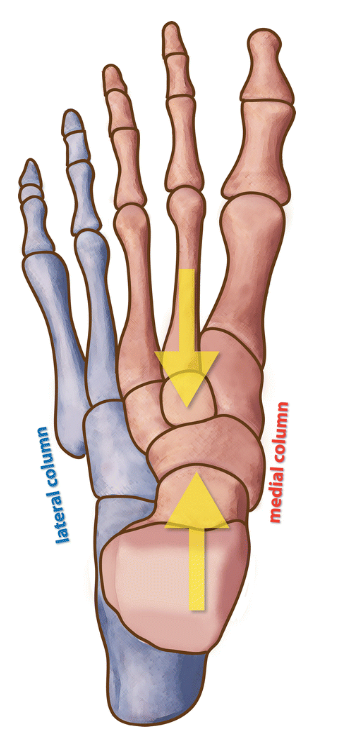
Lateral column overload is a general term given to describe painful overloading on the outside of the foot. As it’s not a specific condition, it can affect various different bones and ligaments located in the lateral column.
What Is Lateral Column Overload?
 The lateral column of your foot (illustrated in blue) includes the heel bone, cuboid bone (in front of the heel bone), the fourth and fifth metatarsals (long bones) and the fourth and fifth toes.
The lateral column of your foot (illustrated in blue) includes the heel bone, cuboid bone (in front of the heel bone), the fourth and fifth metatarsals (long bones) and the fourth and fifth toes.
When the forces acting on the outside of the foot are increased, this part of the foot can become overloaded, leading to pain that may be a one-off, or may linger to become chronic pain. Pain will typically be exacerbated when pressure is applied to the outside of the foot, like when standing on one leg and loading the outside of the foot.
The reasons behind the overloading can vary, but we most often see it in relation to a high arched foot type where the lateral column is bearing significant weight with each step. Some patients may have a very flat foot type with pain, which they are trying to avoid exacerbating by changing the way they walk to shift their pressure on the outside of their foot. We also see lateral column pain together with lateral ankle sprains, cuboid subluxations, and tailors bunions.
Can You Fix It?
Yes. Given the primary cause of the problem is the overloading of the lateral column, our podiatrists have a range of strategies we can use to redirect excessive loads so the lateral column is not under so much strain and pressure.
How Can You Fix It?
We’ll start with a comprehensive assessment that includes a video gait analysis to understand exactly how and why your lateral column is being overloaded. This step is critical as the structures being overloaded and any resulting damage can vary significantly from person to person, and will help guide the best course of treatment for you. Once we have this information, we may use:
Foot mobilisation therapy
Foot mobilisation involves the hands-on manipulation (movement) of stiff, dysfunctional joints in the feet. It operates on the simple but effective principle that when movement restrictions or misalignment in the joints is present, your body will move in a way that isn’t ideal for your muscles, tendons, ligaments and bones. This may place abnormal strain on other parts of the feet, or change the way you walk to be sub-optimal, which can all lead to ongoing pain and injury. Hence, using foot mobilisation to ‘free up’ stiff joints in the feet can help reduce abnormal loading and strain on the lateral column.
Custom foot orthotics
We prescribe and design our foot orthotics completely uniquely for each patient based on the characteristics of their feet, the findings of their assessment, and a 3D scan of your foot. As such, we can create your orthotics to offload the lateral column, distribute pressure more evenly across the feet, and even remove strain from specific structures (like the cuboid bone) entirely. Each person’s orthotics will be different and in line with what is best for their feet, but will ultimately achieve the same goal of best supporting their feet, reducing and eliminating their pain, and helping to prevent the problem from recurring in the future.
Footwear review
We’ll assess your daily footwear to make sure it’s supporting your recovery and not working against you by helping overload your lateral column.
Strapping
Strapping can be useful in immediately and temporarily relieving pressure and strain from the lateral column, giving much-needed relief and comfort.
Stretching and strengthening program
Tight or weak muscles can alter the way our feet and legs work, how other muscles activate, and ultimately how the foot is loaded throughout gait. By identifying tight or weak muscles that are likely involved with the lateral overloading, we can help reduce your symptoms and prevent them from recurring in the future.
Activity modification
We may need you to modify certain movements or activities for a specific time to help remove excess loading from the lateral column.
If you’re concerned about a potential lateral column overload, book an appointment with a podiatrist here.
Frequently Asked Questions
How is a lateral column overload diagnosed?
Diagnosis typically involves a physical examination with one of our podiatrists, which includes an assessment of your foot mechanics and gait. Imaging studies such as X-rays or MRIs may be used to rule out other conditions or assess the extent of the problem.
Can lateral column overload be treated without surgery?
Yes, most cases can and are effectively managed without surgery. Surgery is considered a last resort for LCO when conservative treatments fail to provide relief. Surgical options may involve realigning the foot’s structures or addressing other underlying issues.
Can lateral column overload be prevented?
Prevention strategies include wearing proper footwear, maintaining a healthy weight, strengthening the foot and ankle muscles, and addressing any underlying biomechanical issues through orthotics, physical therapy and other treatment methods.
Can lateral column overload lead to other foot problems?
If left untreated, it can contribute to various foot problems, including plantar fasciitis, Achilles tendonitis, and stress fractures. It can also result in chronic pain and difficulty with activities.
What is the recovery time for lateral column overload?
Recovery time varies depending on the severity of the condition, the chosen treatment, and individual factors. In mild cases, improvement may be seen within weeks, while more severe cases may require several months of treatment and rehabilitation.
